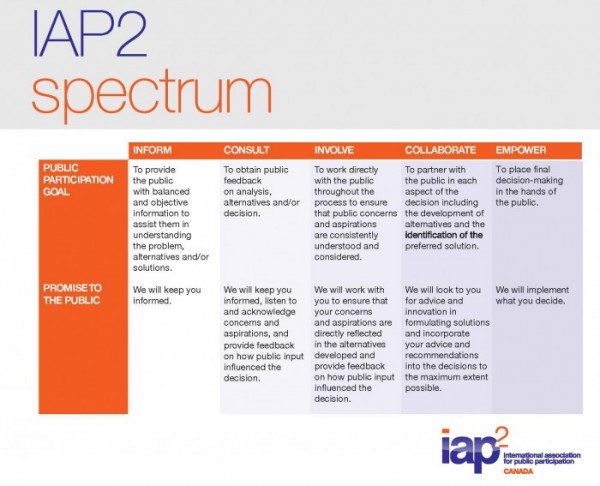
Last week I spent a couple of days in beautiful Prince George, B.C.’s de facto northern capital. I was there to speak to senior municipal administrators at the NCLGMA conference about public participation, and as a bonus also spoke to the local CPRS chapter on the same topic.
Engagement is a bit of a buzzword among public sector administrators. It has grown from something nice to do if the outcome is likely going to be positive, to a process that is an expected part of most decisions that impact one or more stakeholder groups. Gone are the days of taking out an ad in the local paper to advise of a rezoning application and calling the engagement process done.
According to PlaceSpeak, public participation will:
- Increase ownership of programs and issues by citizens
- Allow for transparent and open decision making
- Demonstrate government responsiveness
- Promote dialogue from many parts of your community
Wow, that sounds great! So why aren’t more organizations doing this? There are a lot of reasons, from cost, to staff resources, to lack of skills, to downright fear. It’s difficult to change the way things have been done, especially if there hasn’t been any outside pushback. A quick scan of regional news stories can uncover a number of times local residents or other stakeholders spoke out against a council because of lack of consultation on an issue that was important to them.
Public participation can be straightforward and should be part of all local governments’ processes for new programs, projects or administrative change.
Professional organizations like International Association of Public Participation (a.k.a. IAP2) can help. They provide training, certification and standardization of engagement processes, and give us a common language when describing the objectives, steps and tactics.

Public participation can move an issue from the front page of the news to an outcome embraced by both sides of a dispute.
Case in point:
In 2011 the Vancouver Park Board — where I was working as part of their communication team — came face-to-face with a passionate group of residents who learned many of the stately elms lining their eastside street were going to be cut down. Engagement took the form of a no-parking notice meant to accommodate the tree removal crew’s trucks. The board’s new general manager decided this was an opportunity to change the way the department informed residents and moved the incident from an exercise in issue management to one of collaborative public participation.
Here’s what was done: A stop-work order was issued and an inclusive community task group was formed. An internal review group was also struck to look at the communication and administrative processes in place. There were public meetings, a walking tour of the street and a commitment to a new and transparent process. The outcome? Brand new information materials were developed for the street tree crews, a new system was implemented for reporting tree issues (unsafe trees, places where trees were requested, etc), and a new process for citizen involvement when trees are considered for removal. In the end, only five of the original 31 trees slated for removal were actually cut down and a further 31 were planted in spaces left from previous removals.
Yes, it was uncomfortable to change a process that had been in place for years, especially with significant input from external stakeholders, but it set in motion a brand new way residents and the department interacted.
It also shone a bright light on the value of authentic public participation and transparency.
We’d love to engage with you. Get in touch.

